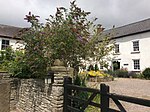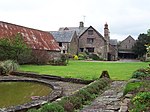St David's Church, Llanddewi Skirrid
Church in Wales church buildingsGrade II listed churches in MonmouthshireWelsh churches dedicated to St David

The Church of St David stands in the parish of Llanddewi Skirrid, Monmouthshire, Wales. The church was Grade II listed in 1956 as an example of John Prichard's work and because of its historic connection to the family of Crawshay Bailey.
Excerpt from the Wikipedia article St David's Church, Llanddewi Skirrid (License: CC BY-SA 3.0, Authors, Images).St David's Church, Llanddewi Skirrid
Old Ross Road,
Geographical coordinates (GPS) Address Nearby Places Show on map
Geographical coordinates (GPS)
| Latitude | Longitude |
|---|---|
| N 51.8482 ° | E -2.9582 ° |
Address
Old Ross Road
NP7 8NL , Llantilio Pertholey
Wales, United Kingdom
Open on Google Maps











